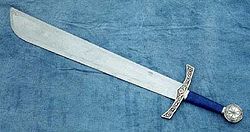Falchion
The falchion or falchion was a sword, used in the Middle Ages, with a single edge and curved at the top, close to from the tip. In English, falchion, used in the Castilian-Leonese kingdom in the Middle Ages[citation required]. Falcione is in Italian. In old Castilian it received the name of cuytelo, that is, "knife", simply.[citation required]
Etymology
The term bracamarte comes from the French braquemart, which appeared in the mid-15th century as a direct translation of the German word Großes Messer ("big knife&# 34;)[citation required]. Originally, the term comes from the Flemish Dutch (breecme) (Braeck-meeser, bone-breaking knife), which referred to large cutting knives. Therefore, the voice falchion is the indirect translation of the German "Großes Messer" or "Langes Messer", which was used to refer to the Central European falchion family. This is why falchion is the most suitable translation for the popular English term falchion[citation required], although in Spain it was also used —and in greater numbers—cutlass and trio for these broad weapons.
Description
The falchion is a weapon with a single-edged blade, whose back (the part opposite the main edge of a blade) often presented a counter-edge in its last third, with a somewhat curved and wide blade as it approached its end. point, or else that its blade widened towards the last third, finishing the edge and spine narrowly. They featured cross-shaped hawks in their early medieval forms, going on to use "S" as they approach the Renaissance, especially in its Italian and German variants.
Origins
The falchion (falchion in English) - according to specialists and historians - is a natural development of large cutting blades, such as the European seax or scramaseax, which were nothing more than large knives without guards that were used in Europe since the antiquity. But in its first appearances, from the 12th to the 13th centuries, together with the falchion appeared large and wide bladed weapons with a multitude of similar shapes or intentions such as the badelaire, the faussar, the faussal, not counting the very large family of Chinese Dao sabers and their variants. Asian -which appeared before our Christian era-, etc.
In Spain it seems that these large leaves from which the falcon was derived received the name of cuytelo or coltell and were well used in Castile and Aragon in the Early Middle Ages. But it is not very clear that they were called falchion before the 15th or 16th century. For this reason it seems that the generic Spanish term for any weapon with a certain curve and width —alfanje— would be the most widely used or the one used by the common people to refer to these swords.
It seems that it was a weapon also used in the peninsular kingdoms and it appears represented on several occasions in the Cantigas de Alfonso X, in the hands of Christians who did not belong to the nobility, although it can also be observed that in some English treatises quite a few warriors appear. well protected carrying said weapon.
Apparently not related to oriental weapons, not exactly a cutlass or scimitar, although it looks similar. Perhaps its direct predecessor is the Nordic seax, large single-edged knives, conveniently oversized and mounted with cross garnishes and discoidal pommels in the fashion of the moment.
In a book on arms and armor by John Hewitt, it is said that there was such a sword belonging to the manor of Sockburn, County Durham, and that with its penetrating edge it was able to finish off a monstrous dragon, worm or snake flying, which devoured men, women and children, and that there is a representation of this sword in the tomb of the great ancestor of the Conyers.
Actually it was a weapon widely used in the Middle Ages by the infantry, the troops, and not by nobles or officers. You might think that because of this fact there should still be many of them today, as a testament to their popularity, which is not true. Only a few remain, from different eras and with notable variations. This is due to the fact that infantry weapons belong to the infantry as an institution, and upon completing their service, many are discharged, being destroyed. Not so the arms of the nobility, which remain as family memories, surviving generations.
Appearance in art
It also indicates that the plywood is a weapon of very remote antiquity because it appears in the paintings of Ramses III in Thebes, 1230 BC. C., and which can also be found, almost identically, in the paintings on the walls of the Ajunta Caves, from the 1st century of the Christian era.
Known Issues
Two falchions can be seen on the ground floor of the Royal Armory of the Royal Palace, in Madrid. Under these you can read:
“The bracamarte, a typical weapon of the Italian Renaissance, follows the shape of the old types of curved blade knives and enlarged staggers its ends that the Germans call krummschwert. This magnificent specimen of Italian bracamarte—or miss—has a single edge, wider to the end, and a leaf with the back profiled to the tip. Under the S-shaped guard, the lap shows a braided motive...”
Contenido relacionado
Herod Archelaus
National Coat of Arms of Mexico
Sculpture from italy
